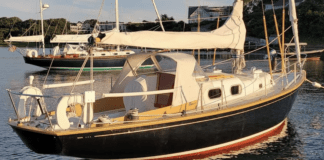Leaving Your Mast Stepped?
Every year when I go to haul my boat I face a certain dilemma. Should I keep my mast in place, or does that invite stress on the boat? For as long as I’ve owned my boat I’ve been having the yard unstep it in the off season when the boat is layed up? Am I wrong to do this?
Bob Nagle
Bonita Springs, FL
This question arises almost each autumn from one or more readers. The issue involves at least two considerations: the hull and deck structure, and the standing rigging.
In a strong wind, vibration of the mast is transmitted to the hull and deck via the standing rigging and possibly the deck partners. When your boat is in the water, this situation is less pronounced as the mast and hull are free to move. On the hill (as they say around boatyards in the South), the vibration can become quite intense. We can’t say with certainty what specific damage this could cause, but we suspect that the area around the chainplate-deck joint would be affected. Leaks here are commonly a nuisance, and can only be exacerbated by wind-induced vibration. When the seal around the chainplate is broken, water can migrate into the deck core or move farther down the chainplate to where it’s anchored. Once there, it could begin to cause delamination, which as all boat owners know is especially bad news.
The vibrations cited above might also lead to gelcoat cracking and an attack on the secondary bonding in the hull, but proving that would be difficult. In any case, unstepping the spar eliminates those possibilities.
The second cause for concern is the standing rigging. While your boat is hauled, water will run down the stays to the terminal fittings. Most terminals are swages that may last years in fresh water environments or when used only seasonally in cold climates. In tropical locations, however, the wear and tear on terminals tends to happen more rapidly, often within a period of five years. This is why mechanical terminals such as Sta-Lok and Norseman fittings are favored here. In the summer, the water collected inside terminals may partially evaporate, in the winter, it freezes and expands. Again, it’s difficult to articulate just how much damage this can cause, but certainly it would be preferable to keep the terminals dry. If you do unstep your spar, the terminals and their turnbuckles should be kept enclosed in plastic and sealed, or protected in some other kind of enclosure for the offseason.
So why do so many people leave their masts up while their boats are hauled out for the long term? One local yard charges $350 to $400 to unstep, store, and restep a mast if it’s already prepped (sails off, etc.). On top of all the other fees you pay to have your boat hauled and stored for the offseason, that’s an expense you can easily rationalize avoiding. But when you consider that unstepping your mast offers a valuable opportunity to inspect the rigging, the sheaves, and the spreaders, as well as any electronics that are housed there, the fees don’t seem so onerous.
Of course careless handling by boatyard personnel-dragging terminals in the dirt, or inadvertently kinking shrouds-can nullify all your precautions, so when we advise you to unstep your spar if at all possible, keep that in mind as our lone caveat.
If you opt to leave your mast stepped, make sure that the rigging is only moderately tensioned. Either way-up or down-you’ll want to run messenger lines for your halyards so that you can remove them and store them in a dry, dark place, away from UV degradation. And keep in mind, if you don’t unstep it this year, you should do so every three to four years so that you can conduct a thorough inspection of its components.







































